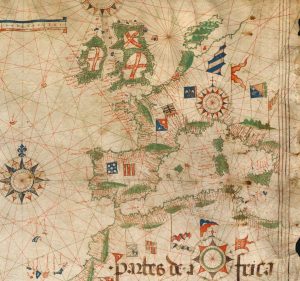“Suffice it to say that James of Scotland had, like everyone else, his spies and agents in England, 1587-1603. Roydon, a fellow member of the Atheists’ Club, apparently did go to Scotland on some mission. When we last hear of him, in 1604, he was living in the household of James’ favourite, William Hamilton, Earl of Haddington.12 We can only surmise at Marlowe’s connection with the intrigues of James. Presumably when he fled to Deptford, Scotland was his ultimate destination” (Gray 696).
- Marlowe may have gone to Scotland to continue working as a spy after his assumed death.
“Various people have been suggested as having really been the Christopher Marlowe who was supposed to have died in 1593. Some examples are a Hugh Sanford, who was based with the Earl of Pembroke at Wilton House in Wiltshire and a Christopher Marlowe (alias John Matthews, or vice versa) who surfaced in Valladolid in 1602, and a Monsieur Le Doux, a spy for Essex, but working as a “French tutor” in Rutland in 1595″ (Wraight 10).
- There are much speculation and many rumors that the Christopher Marlowe who died in 1593 was not the same Marlowe we knew.
- The Marlowe we knew was believed to survive and continue to live his life.
“It is generally accepted that Marlowe had been employed in some capacity as a secret agent, either by the late Sir Francis Walsingham or by the Cecils (Lord Burghley and his son Sir Robert Cecil), or both. He could therefore, theoretically at least, call on powerful friends, with all of the means at their disposal to organize a faked death” (Nicholl 170-175).
- Marlowe had powerful friends while he was believed to be working as a secret agent.
- These spy masters may have helped Marlowe escape out to other parts of Europe where he could continue to conduct work for these spy masters throughout the continent.

“The evidence is in the form of notes which Mr Hoffman, aged 75, an American former theatre critic, received this year from the will of a journalist friend. These say that a 16th century Paduan, Petro (sic) Basconi, left papers stating that an English writer named Marlowe lived with him as a recluse until dying in 1627, 11 years after Shakespere’s (sic) death. The notes add that the writer had “had to leave England” (Farey 1).
- It is believed that Marlowe may have survived until 1627 before finally passing away in Padua, Italy.
- It is unclear what Marlowe did from the years of of his supposed death in 1593 to 1627 but it is possible that he continued to work as a spy in different affairs around Europe.
